Well, we couldn’t even find the bus stop – thanks Mr Google Maps. There should be an instruction booklet, Google Maps for Dummies. We had been walking for around 30 minutes and a friendly Japanese guy asked if he could help us. We told him where we had walked from and he promptly informed us we should have been walking in the opposite direction. Not to worry, he walked us to a bus stop and told us which bus to catch and where to get off. The ride took another 40 or so minutes, but we got there in the end. We didn’t go up to the Temple, as the crowds were too daunting. Mostly Chinese tourists, apparently, so we decided to do the Tetsugaku-no-michi (Philosophers Walk) to the Nanzen-ji Temple.

The trail was quite pretty and peaceful and is a narrow street that runs along a small canal surrounded by cherry trees and is about 1 km and a half long. Its name comes from the Japanese philosopher who taught for several years at the University of Kyoto and it is said he used to walk along this street during his moments of reflection. Making small detours along the way, you can also visit various temples and shrines. The Nanzen-ji is one of the most important Zen Buddhist temples in Japan, it covers a large area with beautiful gardens.
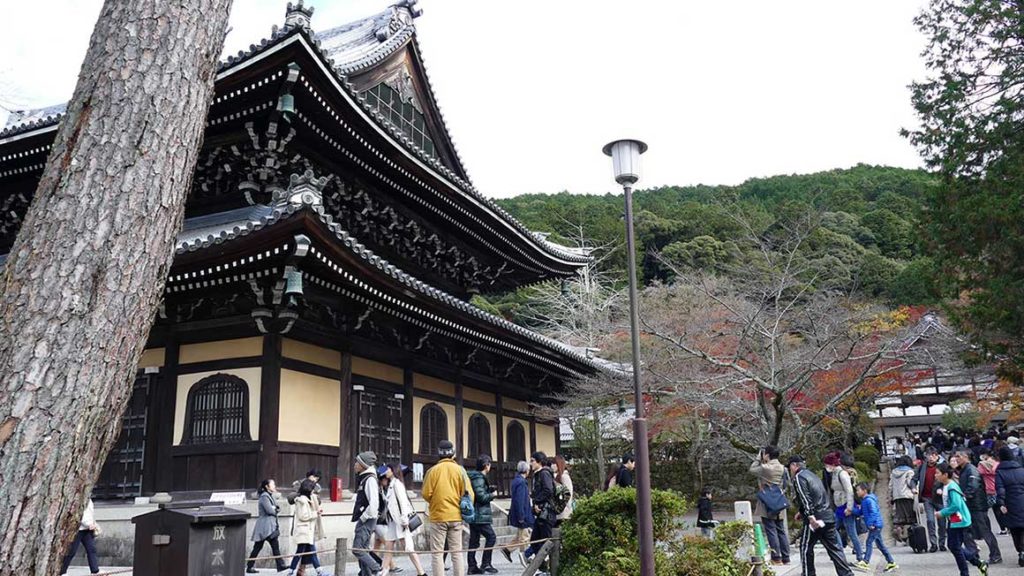
You can have free access to the temple, while the entrance to some buildings has an entrance fee, in particular to the entrance gate (Sanmon, 500 YEN) and to the main building (Hojo, 500 YEN). There are also several small temples, also with admission fee: the Nanzenin Temple (300 YEN), the Konchiin Temple (400 YEN), the Tenjuan Temple (400 YEN). There is within this temple a portion of a red brick aqueduct, part of a system constructed in 1890 to carry water from the nearby Lake Biwa to Kyoto, which is still used today and to which belongs the channel that runs along the Philosopher’s Walk. It is very curious to see a building like this in Japan, it looks like a Roman aqueduct of those found in many Italian cities.

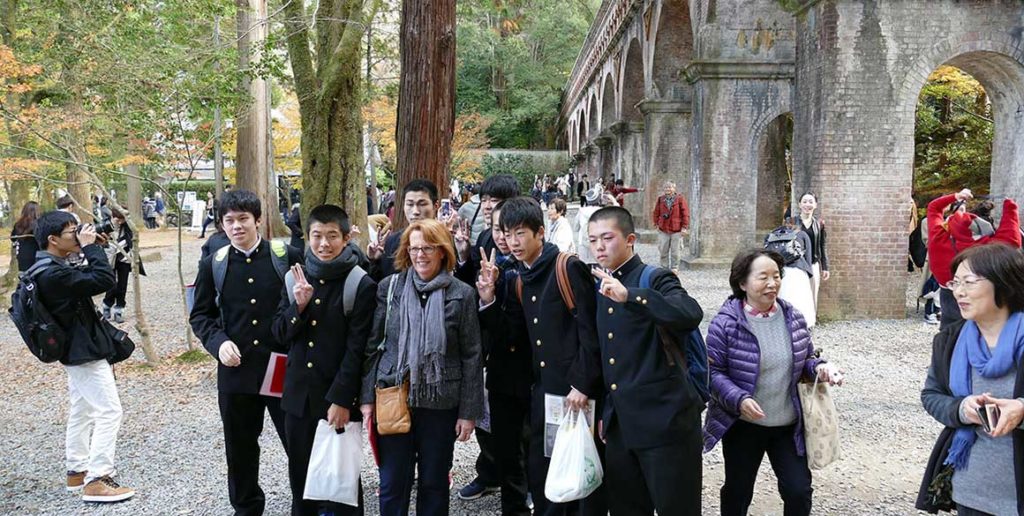
We met up with Michelle and Cae here, before once again parting ways as they continued their explorations by bike. We were both pretty worn out and my back was killing me, so off to Karasuma Starbucks again to impose on their soft armchairs. We walked up the long hill to Keage station and caught the train back. We thought it would be packed, but amazingly, we got a seat. The kids took us out to a vegan restaurant they were fond of, near Nishiki Market, where we all enjoyed a nice meal. It was a fair wait in line to get a table though and it was just about last orders before we got to sit down.
Today Beryl and I caught a bus to Gojo-zaka, where we had 20 minute walk up a hill, to see the Kiyomizu-dera Temple, one of Kyoto’s must-see attractions.
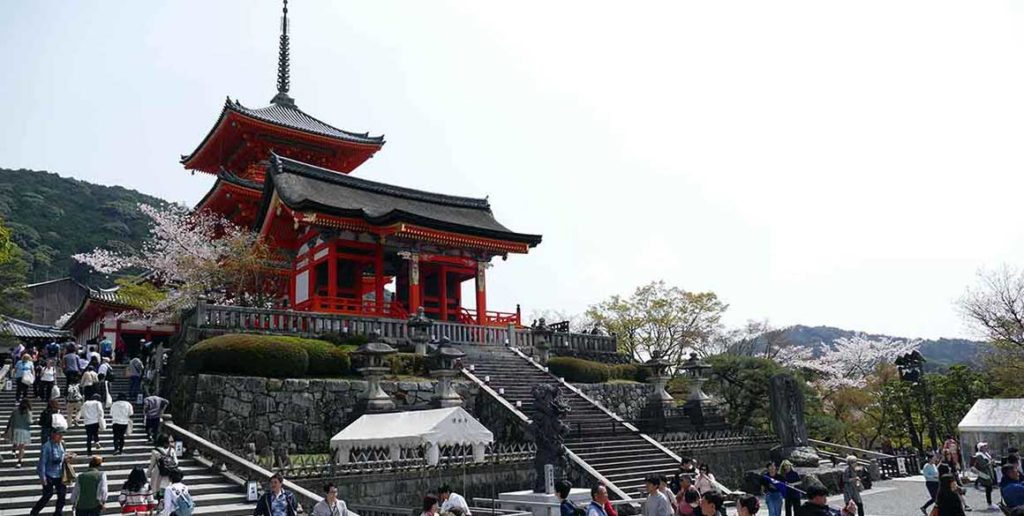
Presiding over the Southern Higashiyama Sightseeing district, with a brilliant view across the entire city, Kiyomizu-dera Temple is just about everything a temple shouldn’t be. It’s noisy, crowded and gaudy, but it somehow manages to transcend all of this to become one of Kyoto’s most worthwhile temples to visit. Start by climbing Chawan-zaka or Kiyomizu-michi to get there and you’ll soon see the brightly painted entrance gate and pagoda. The main hall of Kiyomizu-dera is presently being renovated. Construction is slated to finish in March 2020. During renovation, you can still visit the temple and even enter the main hall, but the exterior might be covered with scaffolding. Kiyomizu-dera is composed of several Buddhist temples. Kiyomizu temple was founded in 798 AD and it is named for a waterfall on the grounds, ‘Kiyoi mizu’ which means pure water. As you climb the stairs to the entrance on your left is the Uma-todome, a set of wooden horse stalls from the Edo Period that was used by visiting samurai. Kiyomizu Temple is entered through the Nio-mon Gate, a two-story structure guarded by two Deva statues or Nio and two koma-inu (Lion dogs). The next gate is the Sai-mon with a cypress-bark roof held up by eight pillars. The gate is decorated with carved elephant heads. The original Kiyomizu Temple dates from the eighth century A.D. when the Shishinden Hall of the Imperial Palace at Nagaoka was moved here. The present buildings were re-erected in 1633 on the orders of the third Tokugawa shogun, Iemitsu. A two-storey gate to the west serves as the main entrance, with statues of Kongo-Rikishi standing in niches on both sides. The main image of the Shishinden is an 11-headed statue of Kannon, the Buddhist goddess of mercy, believed to have been carved by the priest Enchin in the 7th century. The image called a Juichimen-Senju-Sengen-Kannon, is only displayed every 33 years. Close by is a belfry (Shoro) with the bell cast in 1478 and a fine three-storey pagoda, Sanju-no-to, dating from 1633, while to the east are the Scripture Hall and the Founder’s Hall. Asakurado or Asakura Hall was built by Sadakage Asakura (1473-1512), a Buddhist devout and son of the emperor Temmu. As well as being a World Heritage Site, Kiyomizu was recently submitted as a candidate as a New Seven Wonders of the World.

After visiting the temple, we wandered around Sannenzaka shopping street and had lunch on a first floor restaurant. We then followed this road as it wound its way down past Nene no Michi, Kodaiji to Gion – the traditional pleasure and geisha quarter of the city.
On the way is Yasaka Gojonoto, a five-story pagoda. We slogged on until we reached the Kyoto Museum of Traditional Arts, but found it was being used today for a graduation ceremony for 8,000 students at a time. It was packed as they just filed out of both entrances for about 30 minutes. We managed to get in and have a look around, but it will be set down for another visit next time. As we left, the streets were filling up with thousands more coming in for the next ceremony. I was not looking forward to getting the train from Higashiyama Station (which translates as East Mountain, as a young female student informed me) because a continuous line of students were heading to the same station, but it wasn’t too bad. A long day and a tiring one.
Today was a national holiday in Japan and we headed off again to the Nanzenji Temple, whose spacious grounds are located at the base of Kyoto’s forested Higashiyama mountains. This is one of the most important Zen temples in all of Japan. It is the head temple of one of the schools within the Rinzai sect of Japanese Zen Buddhism and includes multiple sub-temples, that make the already large complex of temple buildings even larger. We walked to most of the main buildings and then found a narrow track which led up the mountain to several small and very old shrines. Only saw a couple of other people there, which was a pleasant change from the hordes, lower down the slopes.
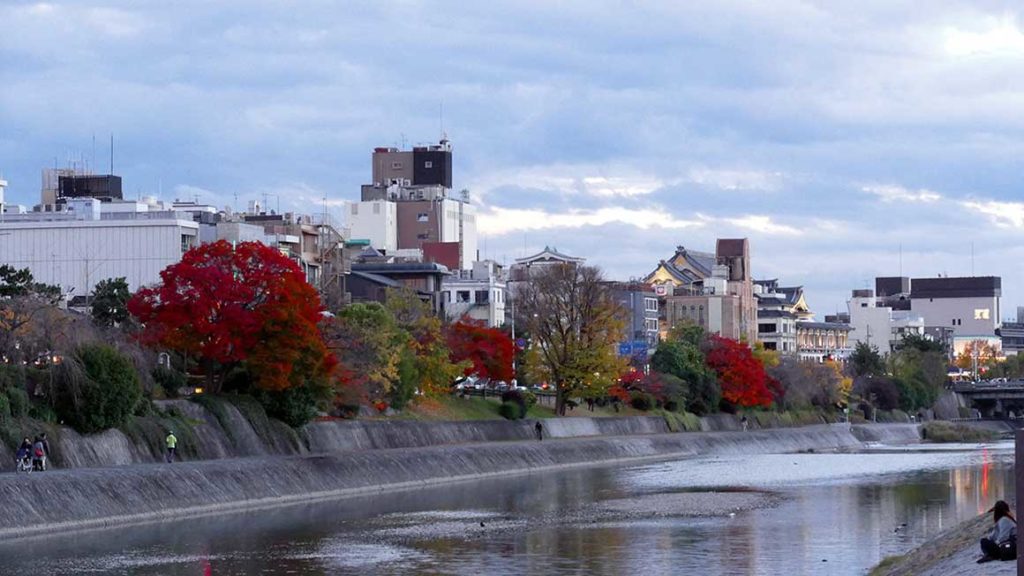
We arrived home around 5pm and went in to our favourite watering hole, Starbucks, where they had very comfortable leather lounge chairs looking out onto a very pretty temple and a colourful city skyline. Much better than sitting on the floor of our BnB and watching the clock tick away. I think we spent several hours each day in those soft chairs, whilst we stayed in Kyoto.
Today was Michelle and Cae’s last day with us in Kyoto, as they had to return to work. We went to Arashiyama, a district in the western outskirts of Kyoto. The area has been a popular destination since the Heian Period 794-1185, when nobles would enjoy its natural setting. Arashiyama is particularly popular during the cherry blossom and autumn color seasons.
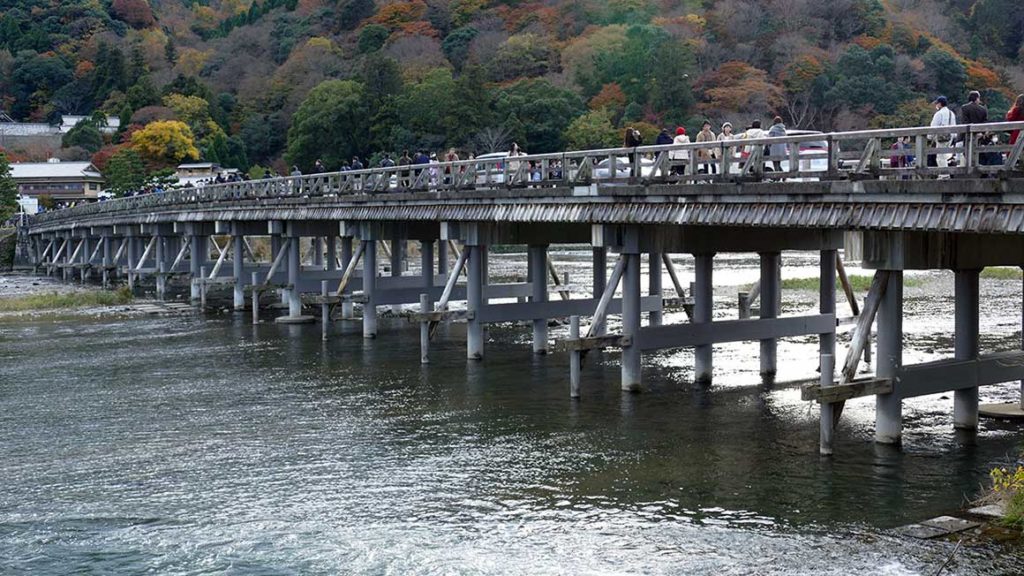
The Togetsukyo Bridge is Arashiyama’s well known, central landmark. Many small shops, restaurants and other attractions are found nearby, including Tenryuji Temple, Arashiyama’s famous bamboo groves and pleasure boats that are available for rent on the river. We caught the train to Karasuma Oike station and then changed for Arashiyama, where we walked to the bamboo forest and then to the Nison-in temple. We also checked out the Togetsukyo bridge.
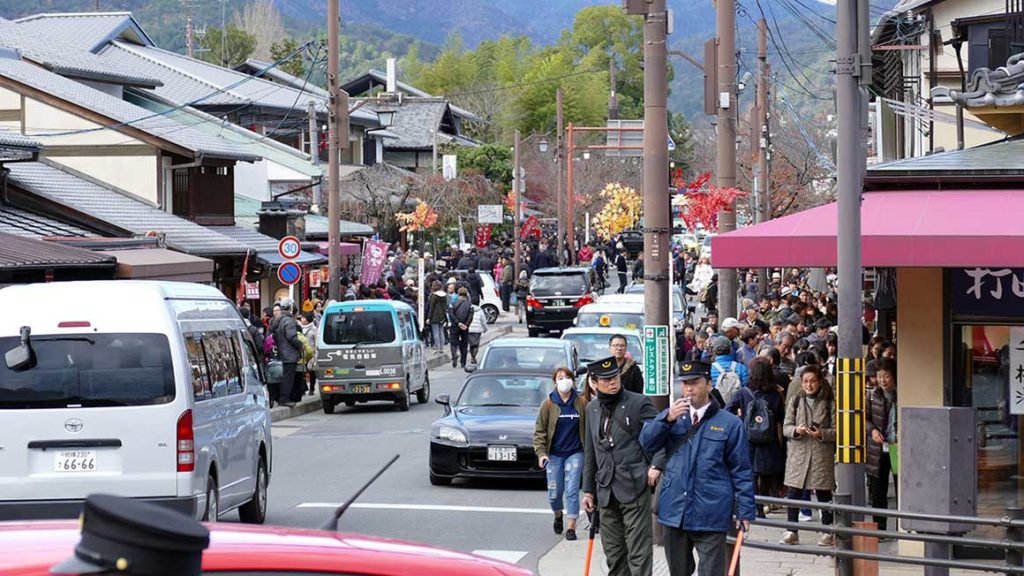
The streets and attractions in this area was by far the most crowded ones we had encountered and at times you just couldn’t move along the paths and roadways. There was also car and rickshaw traffic which had to contend with the huge volumes of humanity.
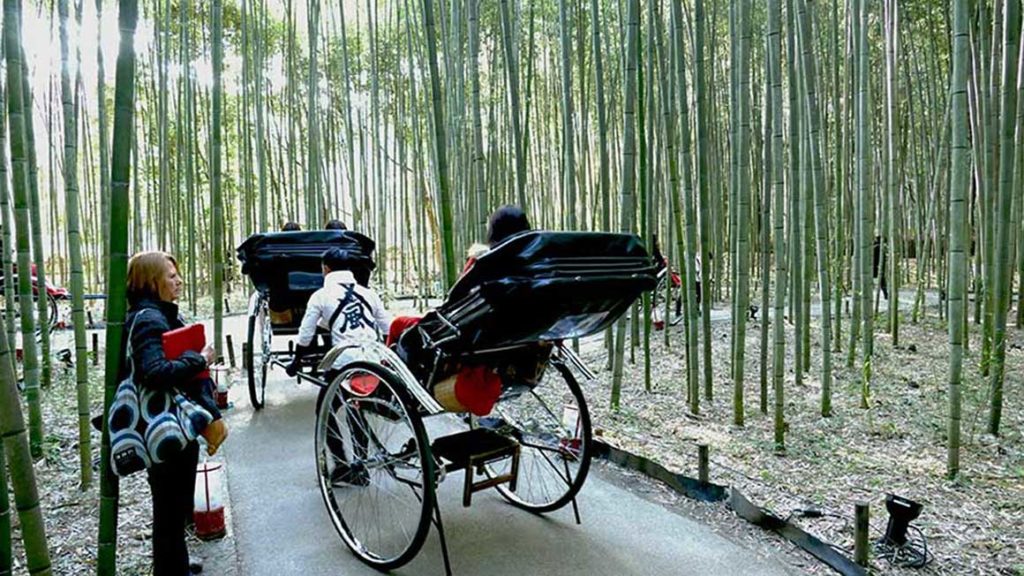
Wow. We said our goodbyes to the kids and went back to the Bnb, ready to head out on our own the following day and hoping not to get lost.
Today was a shopping day, where we spent a lot of time running around trying to get a few items which were on our list. First up, we travelled by train to Kitano and walked several klms, to a street market. I think that they are the same, world over.
Back on the train to Karasuma-Oike, where we went to various stores, including the Aritsugu Nishiki Market, to get a hand made Japanese kitchen knife, but the large variety, crowds of people and cost had me walking out scratching my head.

Caught several trains and finally found the Figure Eight fishing store in Kuinabashi, where I bought some line, which cannot be obtained in Australia.
What a massive store. Three stories and a huge floor area, where I needed a whole day rather than 30 minutes, to explore. Beryl had other ideas though and we were back on the train to find more important stores, like the Misuyabari Needle shop and the Namura tailor shop.
It was almost dark when we arrived back to the unit and we searched around to find a place to eat. Found an Itarian Pizza place (correct spelling) and had a meal there. The menu was fun to read, as the descriptions of the various pizzas had me chuckling. The letter ‘L’ was transposed as an ‘R’ and the ‘A hen loosens and it is a pizza of terriyaki sauce and mayonnaise about the body and a welsh onion’ had me not wanting to experience that unusual variety. Pizzas were ok though. Back to the lounge at Starbucks, to unwind before turning in for the night.
